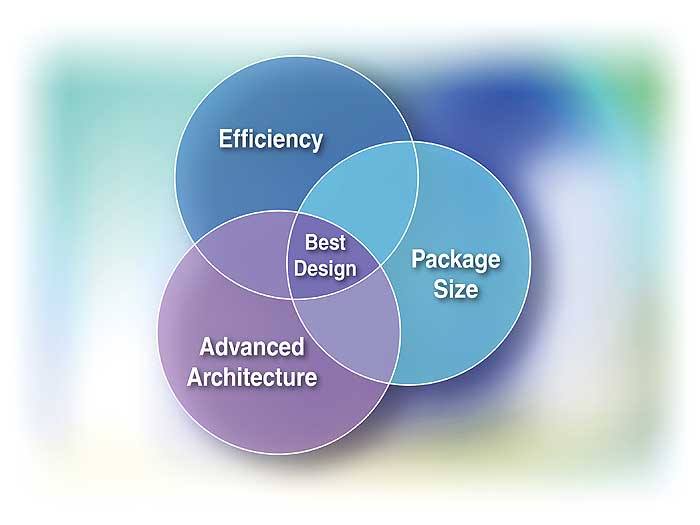Power Supplies Requirements
Studies of data centers in the USA, in 2013, show that they consumed about 91 billion kilowatt-hours of electricity. That is enough to power the largest city in the US for two years. At least 10% – 15% of this power is attributable to losses in: converting AC line voltages to DC, DC/DC secondary conversion and power transmission within the racks of the data center. A quick calculation shows that the losses amount to at least 9 billion kilowatt-hours. This means that every 1% improvement in efficiency saves the US about 1.1 billion kilowatt-hour per year. This, brings us to the subject at hand; Efficiency is overwhelmingly the most important parameter in converter designs as it has a major effect on so many other requirements, like the circuit topology, the PCB footprint needed for the application in all three dimensions, the control architecture used, ease of implementation (time-to-market) and even transient response and ultimately the total cost of the solution.
Analysis
For low voltage DC/DC converters, a synchronous buck converter is the topology of choice since, when properly designed, it offers good efficiency and transient response although, in order to achieve this, the right control architecture must be selected. A voltage mode control achieves good transient response and efficiency but requires
in-depth analysis over the four corners of the loop compensation circuit, seriously affecting time to market in a world where a new version is introduced to the market every few months. The constant-on-time architecture offers a good-to-excellent transient response, good efficiency and ease of implementation, especially since some are self-compensated and require no compensation network, reducing time-to-market. A case in point is Exar’s XR6141 COT controller.
Efficiency is usually improved with a lower switching frequency as this cuts down on switching losses but there is a price to pay and that is the overall increase in size, especially the PCB footprint, as larger inductors and capacitors are needed compared to a higher switching frequency. This often results in a higher cost, plus any height increase may not be accommodated in the target equipment. With the advent of new and exciting power switch technologies such as GaN and SiC, excellent efficiencies at high switching frequencies leading to smaller size can be achieved.
At the present time, these devices are much more expensive than MOSFETs and because of the high switching frequency, expert knowledge in PCB layout is needed. The good news is that the prices are coming down making these technologies more attractive as time goes on. This will lead to a major shift in typical switching frequency from say 200kHz – 800kHz to 10MHz – 100MHz in the foreseeable future. With this comes the extra challenge for passive components, like small size low core loss inductors and ceramic capacitors with high ripple currents in the tens of megahertz range. Power designers will have to acquire the necessary knowhow to design, test and debug these new circuits. With all of the new technologies and knowhow involved, reliability becomes a major concern and must be studied in-depth before large-scale adoption by the industry, in the same way it was done in the 1980’s to assure everyone that the MOSFET is a robust and reliable device.
Another approach is to use a fully integrated power module where the difficult and lengthy process of selecting the right topology, architecture, switching devices and the most optimum power train layout for low parasitics and good EMI compliance has already been done. A case in point is Exar’s XR79120 which boasts a power density of over 2kW/in3 and an efficiency of up to 95%. This is a new trend in power design; capitalizing of the knowledge pool available in semiconductor companies extending from design of controller ICs and MOSFETs to packaging technology and circuit design all under one roof. This allows for the free unencumbered exchange of ideas and knowledge, resulting in multiuse optimized modules that can literally be designed into an application in minutes rather than weeks or months.
Programmable Power Controllers
These controllers are fully controlled via an SMBus-compliant I2C interface allowing for advanced local and/or remote reconfiguration, performance monitoring and reporting as well as fault handling. This type of controller is most suited for base stations, routers and automatic test equipment among other applications.
FPGAs and processors require advanced energy management with voltage control for multiple power rails, programmable over a range from 0.6V to 5V without the need for any external components. These devices must offer a complete sequencing solution to allow the various power rails to be turned on or off in the right order. Programmable switching frequency is a useful feature for 2-stage conversion while the wide range possible with digital pulse-width modulation (DPWM) allows for efficiency and component size optimization. Here a good example is Exar’s XRP7724.
Conclusion
The field of power conversion is undergoing a major reshaping of its fundamental assumptions and established methodologies by the dictates of our modern smart and connected devices and their rapid evolution to meet market demands and get ahead of the competition. A major paradigm shift is needed to move into the world of tens-of-megahertz switching at an efficiency well into the upper 90% while occupying only few square millimeters of PCB space, offering breakneck transient response and a complete design cycle of less than week, all at a cheaper price than the last generation. Great expectations in technological advancements in the field of semiconductors, packaging and control algorithms are expected to deliver these goals.
Author: Alan Elbanhawy, Exar Corporation
Exar Corporation
www.exar.com




